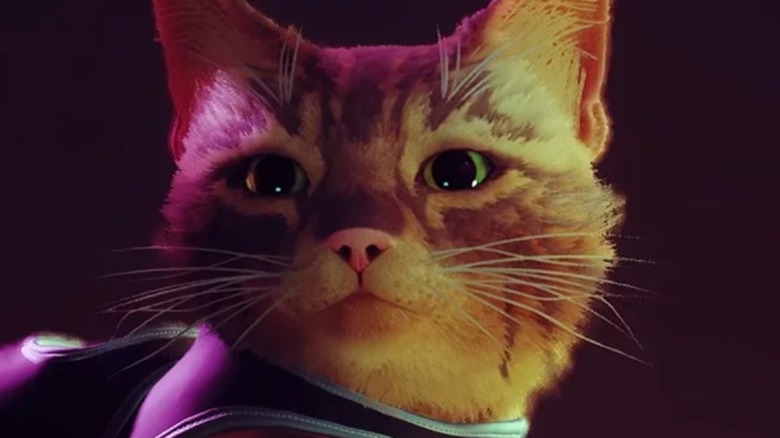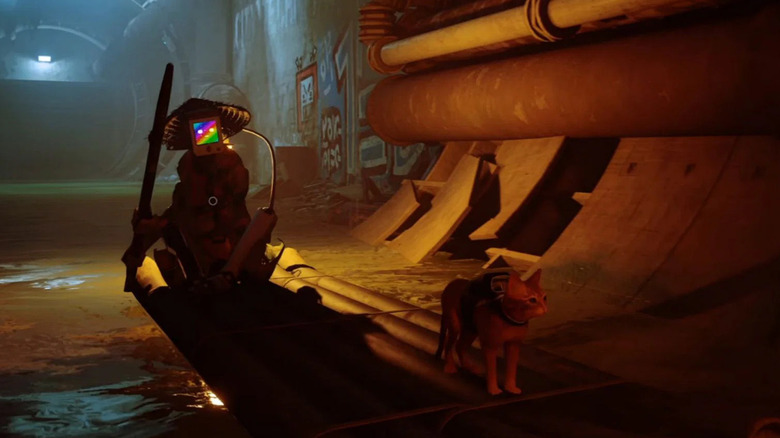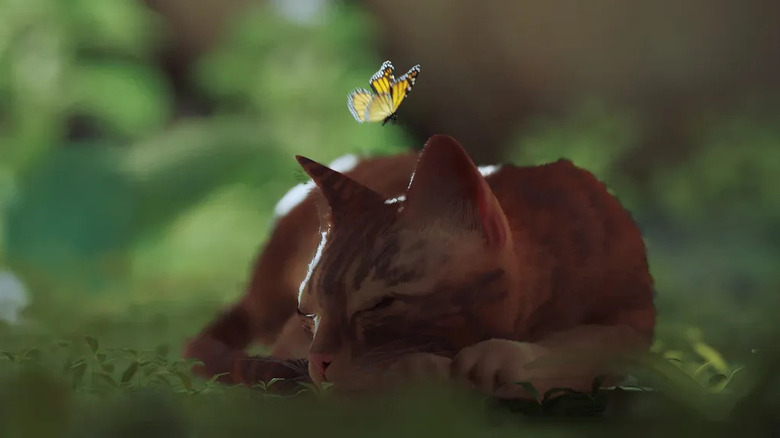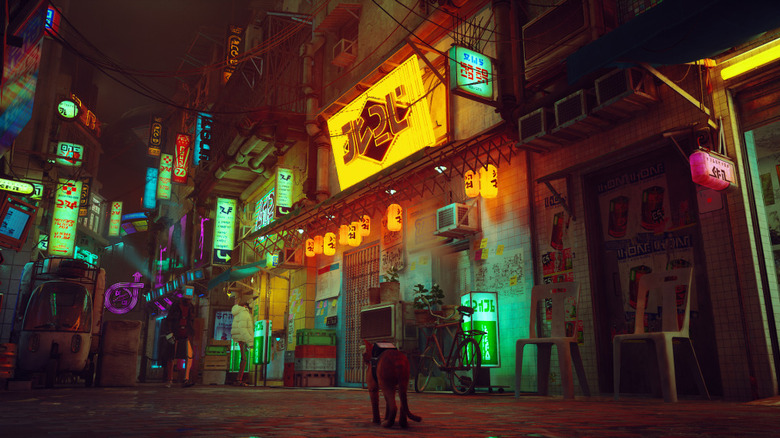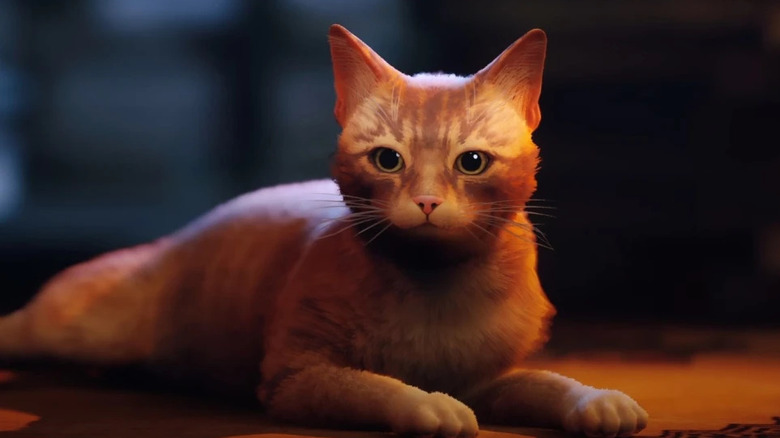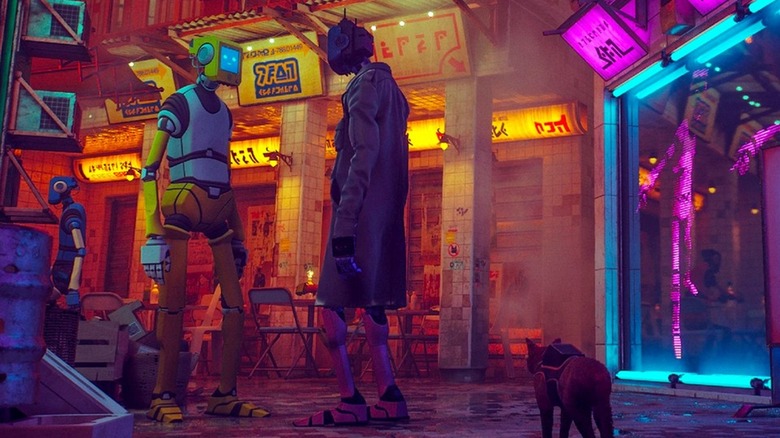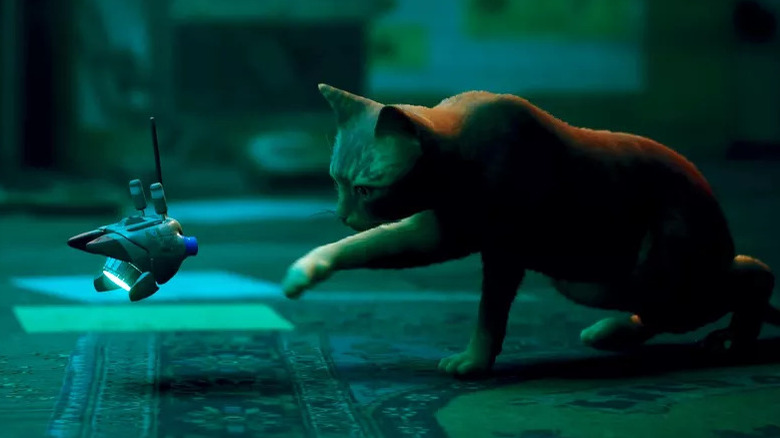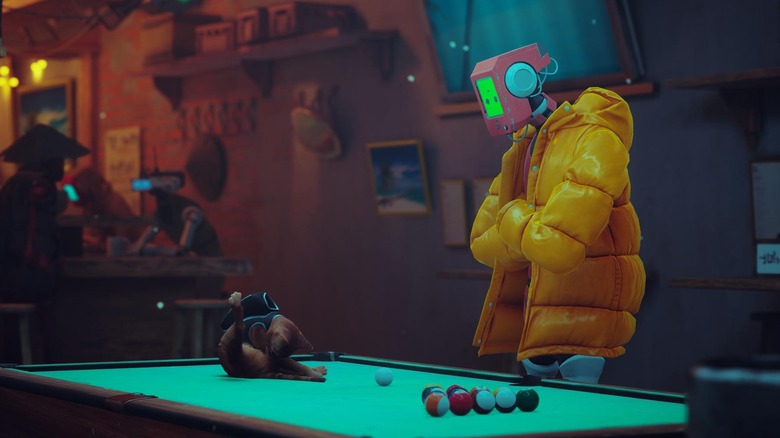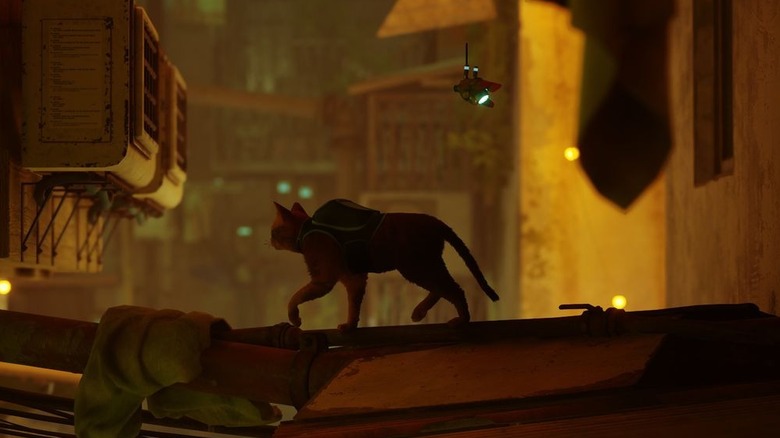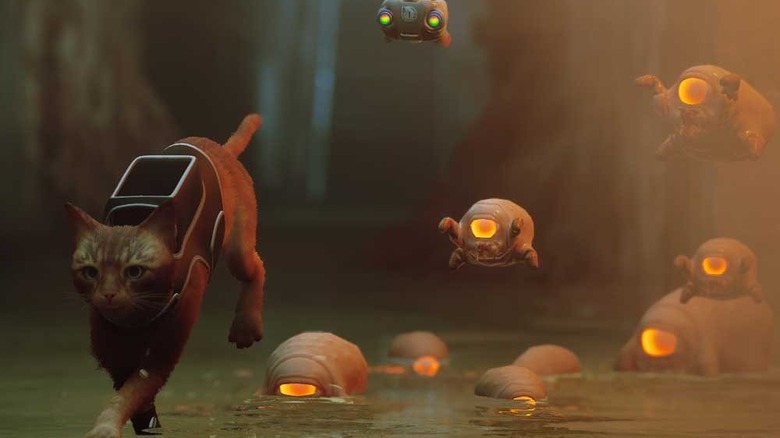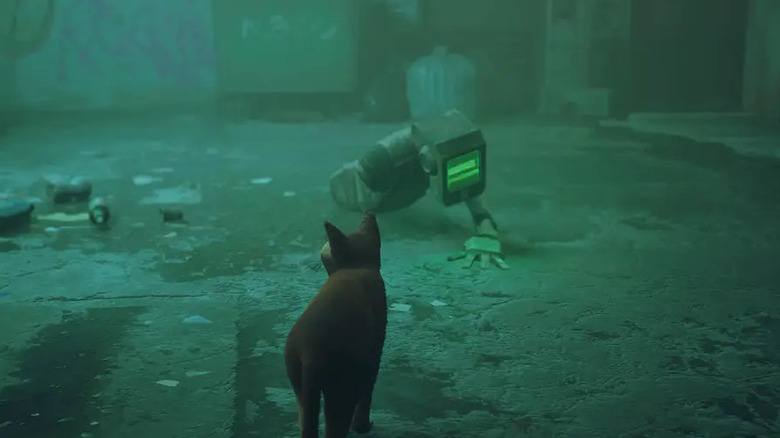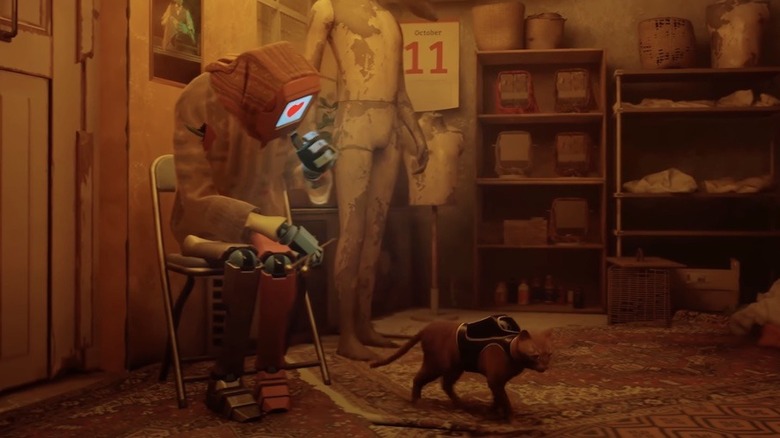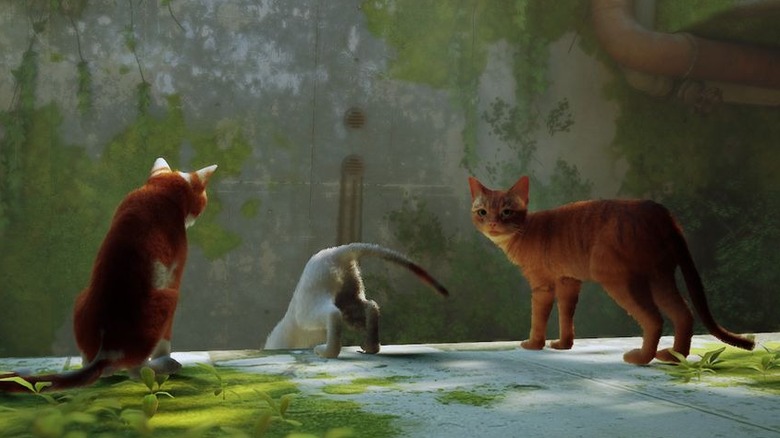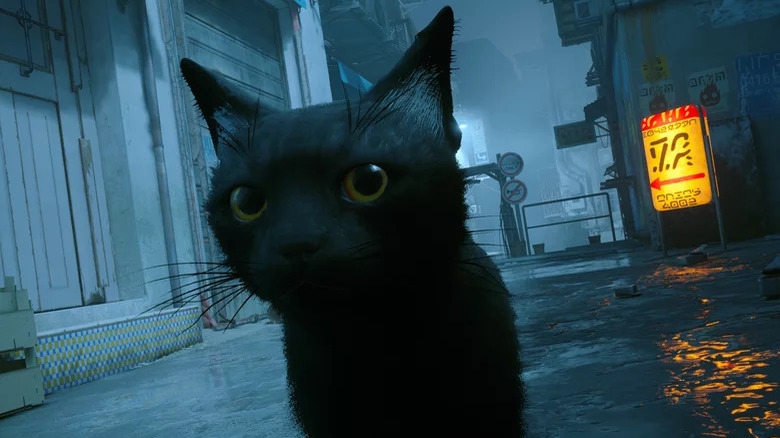The Untold Truth Of Stray
One of the most acclaimed video games of 2022 is "Stray," which was released for the PlayStation 5, PlayStation 4, and PC on July 19, 2022. Developed by BlueTwelve Studios and published by Annapurna Interactive, the game allows players control a stray cat in a vision of the future where humanity has gone missing and sentient robots occupy the abandoned cities. With its neon-lit, cyberpunk setting and its promise to deliver on the joys of exploring the world as a cat, "Stray" has all the makings of a modern masterpiece. And considering its development cycle began all the way back in 2015, there is a lot of untold behind-the-scenes history from the journey to bring the popular video game to life.
Here are the most intriguing secrets revolving around the creation of "Stray" that have since surfaced since the game's launch. From the game's real-life inspiration that led to one of the most pettable cats in gaming history to the influences behind the titles hauntingly beautiful world, these details helped shape "Stray" into the celebrated title that it is today.
Stray took inspiration from... Lethal Weapon?!
The developers at BlueTwelve Studio didn't just model the main cat in "Stray" exclusively after a single cat, but a whole host of felines. In fact, the cat was inspired by cats owned by some of the developers themselves. BlueTwelve Studio founders and "Stray" game directors Colas Koola and Vivien Mermet-Guyenet own two cats that directly helped inspire them to make the game. And in a fun twist, the two cats are named after Martin Riggs and Roger Murtaugh, the buddy-cop duo seen throughout the popular "Lethal Weapon" film series. This last fun fact was confirmed by the developers in a PlayStation spotlight blog.
The feline Murtaugh played an especially inspirational role for the development team, as another PlayStation blog post revealing Murtaugh was an actual stray cat that was rescued after being discovered under a car in Montpellier, France. Two other cats, Oscar and Jun, were also kept in the studio during development, and their movement and behavior was studied extensively for the game character's animation. Danny Glover and Mel Gibson have yet to publicly comment on their "Lethal Weapon" characters' namesakes informing the production of "Stray," but one assumes they'd hopefully get a kick out of it.
80% of the development team owns cats
More than just Koola and Mermet-Guyenet's buddy-cop named cats, the vast majority of BlueTwelve Studio's "Stray" team are cat owners themselves. In an interview with Screen Rant, game producer Swann Martin-Raget estimates that 80% of the development team either own cats or are major cat lovers in their personal lives. Martin-Raget felt this distinction helped make "Stray" even more of a passion project for the developers and underscored the importance in crafting an accurate depiction of cats within the game.
Though most of the developers haven't publicly shared pictures of their cats online, a PlayStation spotlight blog has provided a look at Murtaugh, Oscar, and Jun. Murtaugh, in particular, resembles the feline protagonist of "Stray," with his orange coloring, and is cited as a primary inspiration behind the main cat. Martin-Raget points out that though the team's personal connection to cats helped motivate them, they do not consider themselves scientific experts on feline biology as they developed the game.
Stray's cyberpunk city shares cinematic and real-world influences
Much of "Stray" takes place in a cyberpunk city which has long since lost its original human denizens, with the locale now primarily populated by robots that carry out surprisingly humanlike activities. The setting is vaguely reminiscent of East Asian cities, from the layout of its architecture and prominent use of neon lighting, the game's developers looked to two major influences in designing this stunning city. One source of inspiration was the classic science fiction film "Blade Runner," while the other came from the defunct Hong Kong neighborhood of Kowloon.
In an interview with Inverse, Martin-Raget observed that the developers have "always been fascinated by films like 'Blade Runner,'" which informed the game's overall aesthetic of bright billboards and rigid buildings. Martin-Raget also said that the unique design of Kowloon led the team to view it as the perfect playground from a cat's perspective when developing "Stray." The walled city was an enclave established within Hong Kong in 1898 before being demolished and replaced with a city park in 1994.
No motion-capture was recorded to develop the cats' movements
With such a naturalistic depiction of cats, right down to movement and fully articulated design, one might assume that the "Stray" development team utilized motion capture to more realistically obtain accurate data on cat behavior. However, according to Martin-Raget, no motion capture was employed by the developers, who instead used plenty of reference material to inform how they animated the game's cats. This was spearheaded by Miko, who headed the team's cat animations, and preferred using more analog methods to animate the cats of "Stray" rather than rely on motion capture.
In an interview with Rock Paper Shotgun, Martin-Raget said that everything was animated by hand. Martin-Raget elaborated, in an interview with Inverse, that the developers didn't want to put cats in uncomfortable motion capture rigs — and they ultimately felt that some of the animations in "Stray" were too dangerous to create using real cats. Instead, Miko and the rest of the team happily observed cats in the studio while animating the game.
Human NPCs were considered early on
As players explore the cyberpunk world of "Stray," it quickly becomes apparent that the story takes place long after humanity has either died out or left the planet behind. Instead, synthetic beings have gained their own autonomy and have come to emulate human life themselves — from playing music to lounging in bars — in the ruins of the old world. Despite this conceit, there were early plans for "Stray" to take place in a setting still populated by human NPC characters before shifting to robots.
Swann Martin-Raget confirmed that, while developing "Stray," BlueTwelve did several design tests on human NPC models with the intent to add them to the game. Finding the process of designing quality human models too time-consuming and unnecessarily difficult for such a small team, the developers decided to drop the idea. Instead, the robots apparently allowed for a smoother design process. This worked out in the long run, as it then inspired the team to create a fascinating, human-less story and world to accommodate the change.
B12 was introduced to complement the cat
With "Stray" set in a cyberpunk future, the developers were keenly aware that there was only so much a lone cat could do, gameplay-wise over the course of the story. These natural limitations led the developers to come up with innovative ways to add more variety to the mechanics and keep the proceedings fresh for players. BlueTwelve created the cat's robotic companion B12, a helpful sidekick that rests in the cat's backpack when it's not hovering around.
In an interview with Inverse, Martin-Raget observed that the futuristic setting would not be naturally intuitive for a cat to interact with over the course of the game. In turn, B12 could interface with various technology, which is a bit outside of a cat's realm of experience. After introducing B12, the developers crafted a story about the burgeoning relationship between the cat and robot that serves as the game's emotional core.
The game's world was designed before its premise
Given the developers' interest in cyberpunk settings and the look of the walled city of Kowloon, the team began crafting virtual environments early in production, even before the full premise of "Stray" came into focus. In an interview with Video Games Chronicle, Swann Martin-Raget revealed that the developers first created graphical tests of the environments that would eventually become the world of "Stray." It was only after the developers realized that these environments would be perfect for a cat to explore that the premise of the game began to take shape.
Upon reaching this realization, the developers began to work extensively on developing different gameplay mechanics that would make sense for a cat as it navigated these cyberpunk environments. In an interview with VG247, Martin-Raget elaborated that this shift in focus, observing that the platforming elements meant cat jumps were designed to be intuitive and precise. This precision and emphasis on seamless jumping mechanics meant that the developers could design and explore the environment with a sense of verticality that's not always found in traditional platforming.
The action sequences serve a specific purpose
Controlling the main cat is a central element of "Stray," but the developers were never particularly interested in creating a mere cat simulator with this project. More than simply rewarding players for exploring this futuristic city, the team was intent on adding surprising layers and directions for the game to go. This meant adding action set pieces and enemies for players to confront over the course of the story. However, these sequences and characters served a greater purpose beyond instilling stakes and a sense of peril.
In an interview with Screen Rant, Martin-Raget observed that cats didn't really belong in the robot-populated world of "Stray," and the dangerous elements scatteed throughout the city underscored that point. Martin-Raget explained that the action sequences also changed up the game's overall rhythm, helping players stay engaged and surprised by the proceedings. The implementation of action and stealth was made deliberately to drive the game's story, providing a fuller gameplay experience for players. Players probably would have been fine with a game that just let them walk around and interact with robots as an adorable feline, but BlueTwelve kept pushing for more.
The Zurks have an annoying real-world inspiration
The first enemies players encounter over the course of "Stray" are Zurks, persistent parasitic creatures that attach themselves to the cat and attempt to drain its life force. This noticeably slows down the cat and allows them to be swarmed by an entire group of Zurks, resulting in the cat's death if players aren't careful. And for inspiration in designing the Zurks into "Stray," the development team looked to an uncomfortable experience from their own lives to transpose into the game.
After enduring a bout of bedbugs, Colas Koola and Vivien Mermet-Guyenet decided to bring a facsimile of these bloodsucking parasites into "Stray" as a recurring enemy. Later in the game, as the cat ventures into the more infested areas of the city, B12 gains the ability to destroy Zurks with bursts from a powerful ultraviolet light. In a print interview with Edge 365, the developers shared that this mechanic gave them a sense of revenge against the bedbugs that had once plagued them in their personal life.
There are exactly two instances where the protagonist can die
Although "Stray" offers a great deal of joy to players as they explore, the cat's journey isn't an entirely inconsequential adventure. Failure does occasionally have a price in "Stray."
To give the game a greater sense of stakes, the developers decided to include some moments where players can indeed see their feline protagonist killed if they aren't careful. However, even with the inclusion of these lethal stakes, the developers were strategic in how these sequences were employed in the game.
In an interview with Screen Rant, Martin-Raget pointed out there are exactly two instances in which the cat can die: either being swarmed by the parasitic Zurks or being hunted by the Sentinel drones. In order to mitigate mounting frustration from players stuck in a particular sequence, the developers also added shorter checkpoints during perilous scenes. The developers were also careful in how they staged the few sequences with mortal consequences, avoiding placing the cat in danger for an overly prolonged period.
Real cats gave the developers feedback
As production on "Stray" continued, the development team began to weave the game's disparate elements together, from the protagonist to the futuristic setting. Along the way, developers found a surprising source of quality assurance as work progressed: the cats in BlueTwelve's studio used for design reference. As they observed the cats reacting intuitively to "Stray" on-screen while it was displayed in the studio, the game received the ultimate vote of confidence from its feline critics.
In an interview with For the Win, Swann Martin-Raget shared that cats in the studio would begin to respond to the game, either after hearing meows or seeing cat animations on-screen. The developers took this as a sign that they were on the right track when it came to nailing a relatively realistic depiction of a cat in their game. Sometimes constructive criticism comes from the unlikeliest of places.
However, when the game became a hit with audiences worldwide, it turned out that the developers' cats weren't the only ones getting drawn in by the action in "Stray." Gamers' cats are reportedly just as captivated by the feline protagonist, from the use of the meowing button to the intuitively realistic movement animation of the cat on-screen. From moving up closer to TV screens displaying "Stray" to incessantly watching the video game from a place of comfort, "Stray" is connecting with real-life pets. Not only that, but even some dogs have reportedly served as an impromptu audience for the game, much to the delight of their owners.
Stray's publisher is helping save real cats' lives
More than simply crafting the adventures of a cat in a cyberpunk world, the makers of "Stray" are out to save the lives of stray cats in the real world. To mark the launch of the new game, publisher Annapurna Interactive decided to partner with several nonprofit organizations around the world dedicated towards helping stray animals. Annapurna sent out free download codes for "Stray" to animal shelters in the United States and the United Kingdom, offering giveaways for those that pledge cash donations to the shelters (per Associated Press).
While a shelter in Nebraska offered the codes in exchange for the game, the British nonprofit organization Cats Protection offered codes for those that participated in a promotional campaign. The campaign asks its entrants to use livestreams to promote awareness of Cats Protection's mission to rescue and rehome stray cats around the U.K. With these partnerships and charities, Annapurna is putting its money where its mouth is, helping stray cats on both sides of the Atlantic Ocean while sharing the acclaimed game.
Cat owners are modding their pets into the game
With real-life pets connecting with "Stray" and the game being a bonafide hit with cat owners, players have begun to add their own personal touch to the game by modding the feline protagonist to resemble their own cats. A modder going by the username Norskpl has been taking commissions to do just that. Working on a name-your-price basis, Norskpl takes photos of beloved pets and uses them to craft custom downloadable cat textures for the game. Because of the immediate enormous influx of requests for custom "Stray" mods, Norskpl actually had to announce that they were suspending acceptance of mod requests for two weeks to catch up on existing orders. Clearly, there's a serious demand for this.
As it currently stands, the custom cat mods for "Stray" are only available for the PC version of the game and not its home console release. But in a way, these mods make the game feel like it's truly come full circle. The "Stray" development team had looked to their own cats for inspiration and, thanks to these mods, players will get to have a similar experience. It's basically a dream come true for cat lovers who also enjoy "Stray."

